VS2017 編譯 Visual Leak Detector + VLD 使用示例
起因
一個Qt5+VS2017的工程,需要進行串列埠操作,在自動時發現一段時間軟體崩潰了,沒有儲存log,在 debug 的時候發現每執行一次應用佔據的記憶體就多一點,後來意識到是記憶體洩漏了。這個真是頭疼,變數太多,不知道從哪裡查詢記憶體洩漏好。於是迫切的需要找到一種追查記憶體洩漏的工具。
一開始很自然的是vs2017 debug檢視記憶體佔用情況,採用的就是這個博文 https://blog.csdn.net/luoyu510183/article/details/84728664的思路,然而太麻煩了,放棄。後來無意中發現 Visual Leak Detector 這個工具,簡直完美了。
VLD 簡介
官網介紹說 VLD 時一個免費的、健壯的、開源的針對 Visual C++ 的記憶體洩漏檢測系統。
使用方式非常簡單,在安裝之後,只需要告訴 Visual C++ 標頭檔案路徑和庫檔案。只需要在原始檔中新增一行程式碼即可使用 #include <vld.h>
在 Visual Studio debugger 執行的時候, VLD 會在 debug 會話結束之後把檢測報告列印到輸出視窗。記憶體洩漏報告包括完整的呼叫堆疊顯示記憶體庫是如何分配的。雙擊呼叫堆疊上的行號即可以跳轉到編輯器對應的檔案行。
Visual Leak Detector 官網地址 https://archive.codeplex.com/?p=vld,它已經遷移到了 github 。
VS2017編譯VLD
不湊巧的是官網更新到2015年,支援vs2015,所以只能從原始碼開始編譯 vld 了。可以從官網或者 github 下載原始碼。
解決編譯問題
前面說了原始碼只支援 vs2015,用 vs2017 一開啟就出現了問題,原始碼最高支援 vs2015 編譯器,如下圖所示:
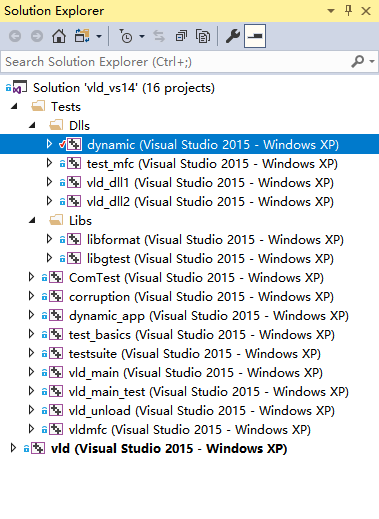
支援vs2017編譯器
上面的這個問題,一般只需要重新定位編譯器即可,滑鼠右鍵 "dynamic" 目標在彈出的選項中選擇 "Retarget Projects",雖然 輸出視窗顯示操作成功了,但是實際並沒有。

這是因為平臺工具集不對,需要手動修改每一編譯目標的平臺工具集,這裡以 dynamic 編譯目標為例,修改它的屬性,如下圖所示:
在 General-->Platform Toolset 中重新選擇,如果有多個選擇,請選擇一個合適的工具集,這裡選擇 Visual Studio 2017 (v141)。(其他的編譯目標執行一樣的操作。)

變更為 x64 工程
在編譯之前需要把 "win32" 改成 "x64",因為我的電腦是64位的,應用環境也是64位的。然後 Build Solution。然後就出現了 “Windows SDK 8.1” error。

按照提示,選擇 Retarget Projects 然後選擇最先的SDK版本,然後對其他的編譯目標執行相同的操作。
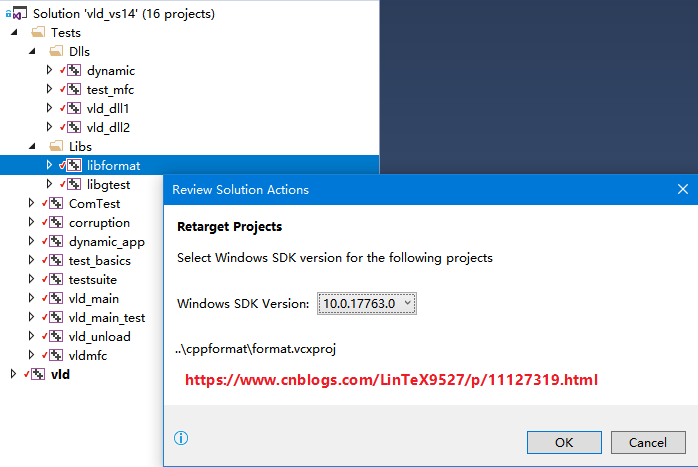
定義巨集 _SILENCE_TR1_NAMESPACE_DEPRECATION_WARNING
編譯,又出么蛾子了,提示 _SILENCE_TR1_NAMESPACE_DEPRECATION_WARNING 定義這個巨集可以避免錯誤,所以需要執行如下的操作:
開啟工程 libgtest 的屬性設定介面,C++-->Precoessor-->Processor Definitions 中新增一個巨集定義: _SILENCE_TR1_NAMESPACE_DEPRECATION_WARNING
對其他的編譯目標執行相同的操作,然後編譯。

Unsupported compiler
執行上面的操作之後編譯提示 Unsupported compiler,雙擊這個提示跳轉到原始碼 allocs.cpp 第37行,跳到 _MSC_VER 定義的地方一看,原來 vs 2017 的版本是 1916,同時搜尋一下本地電腦上 Microsoft SDK 是否包含 ucrtbased.dll 或者 msvcr120d.dll,經過查詢 VS2017 確實包含的是 ucrtbased.dll,新的定義如下:
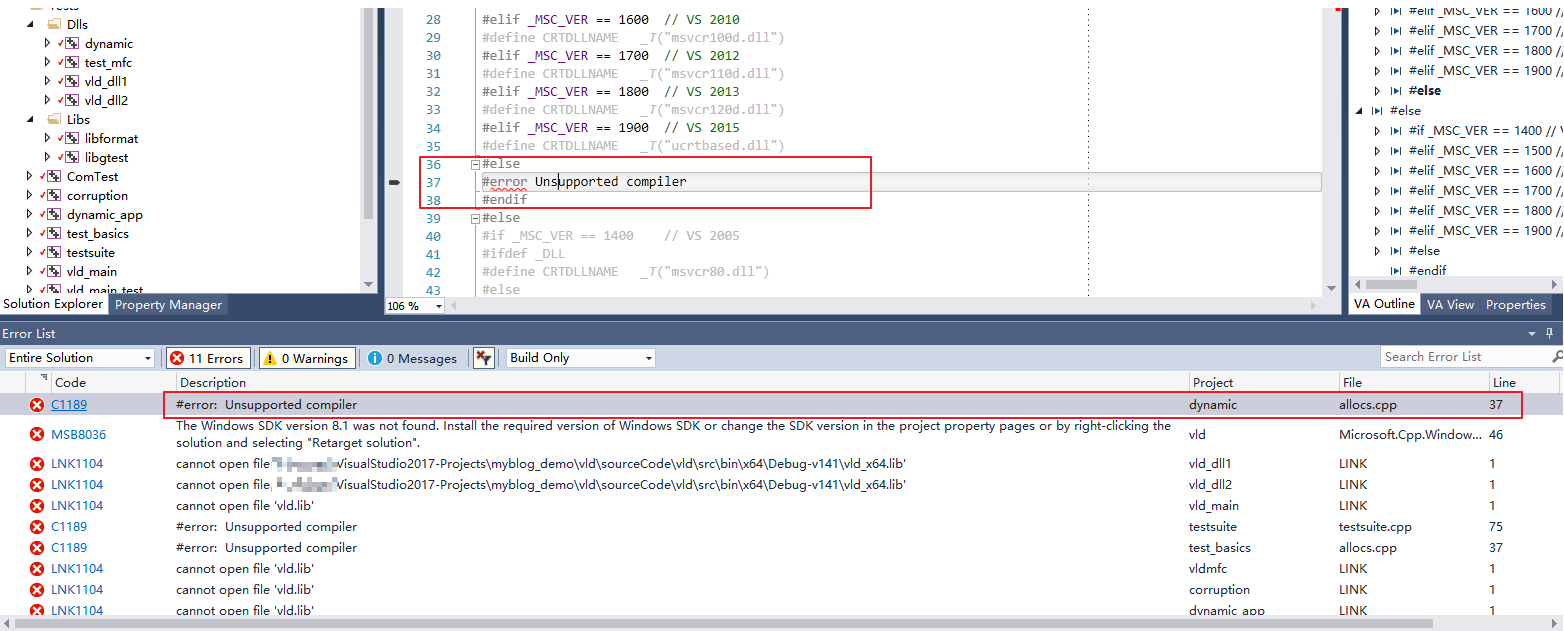
#elif _MSC_VER == 1800 // VS 2013
#define CRTDLLNAME _T("msvcr120d.dll")
#elif _MSC_VER == 1900 // VS 2015
#define CRTDLLNAME _T("ucrtbased.dll")
#elif _MSC_VER == 1916 // VS 2017
#define CRTDLLNAME _T("ucrtbased.dll")
#else
#error Unsupported compiler
#endif其他的編譯目標出現相同的問題,採用相同的解決方法。
Not supported VS
上一步編譯之後提示如下,跳轉到對應的原始檔 vld.cpp 第 976 行:

很明顯這是因為 vs2017 對應的版本號是 1916,所以修改為 _MSC_VER > 1916 即可。
cannot open file vld.lib
上一步編譯之後提示找不到庫檔案 vld.lib

例如這個工程編譯產生 lib 資料夾內容如下:

需要向報錯的工程中新增庫檔案路徑和庫檔案,但是這麼多編譯目標,一個一個設定庫檔案路徑和庫檔名,煩都煩死了,所以新建一個 property sheet,然後每一個工程新增這個屬性就可以了。
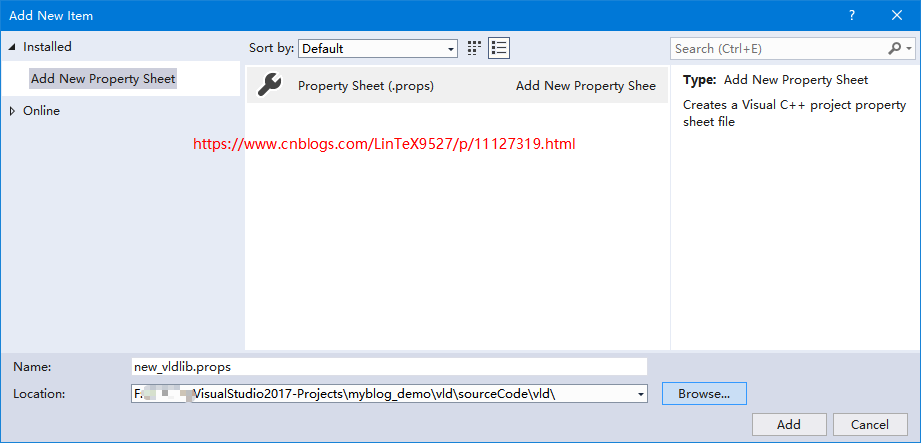
新建的 property sheet 內容如下
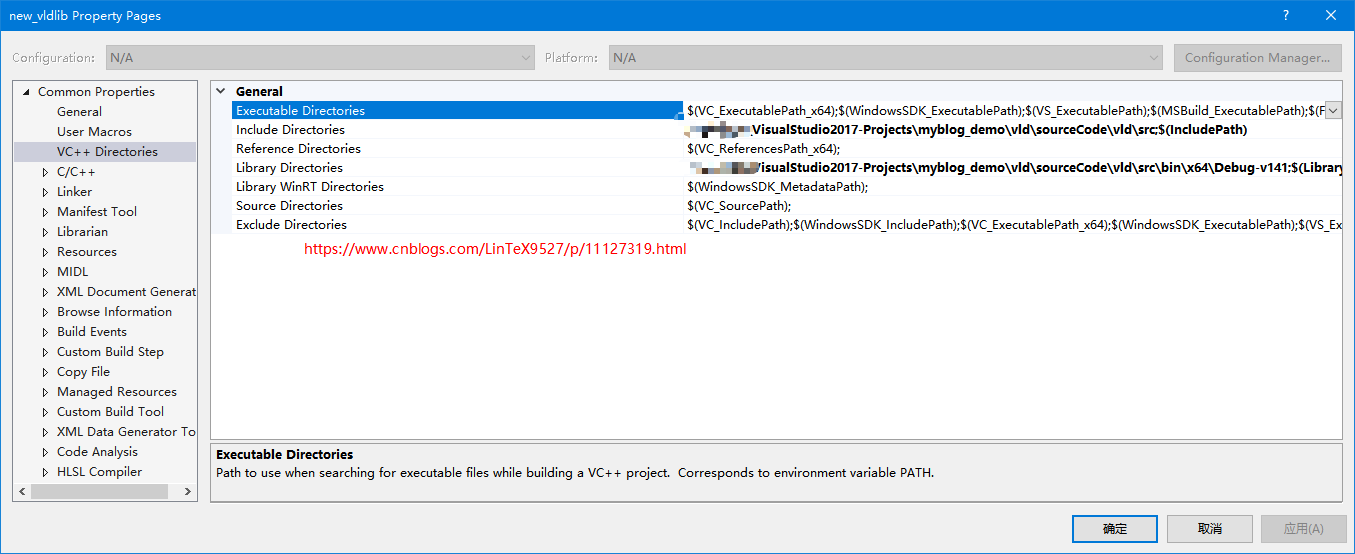
每一個找不到 vld.lib 的編譯專案都新增這個屬性就可以了。
編譯通過
========== Rebuild All: 16 succeeded, 0 failed, 0 skipped ==========
VLD 最簡單示例
一個最簡單的示例,程式碼如下:
#include "pch.h"
#include <iostream>
#if _DEBUG
#include "vld.h"
#endif
int main()
{
int *pint100 = new int[100];
std::cout << "Hello World!\n";
short *pshort100 = new short[100];
}在編譯之前需要確保是 Debug, x64,並且把上面的 property sheet 拷貝到當前目錄,並且新增到這個工程中,編譯執行,彈出了“無法找到 vld_x64.dll ”的錯誤,簡單,拷貝上面的工程產生的 vld_x64.dll到這個工程的 Debug 目錄,重新啟動除錯,又出么蛾子了。

無法啟動, 0xc0150002
解決方法參見這篇博文 https://blog.csdn.net/u012248603/article/details/52639578,
只需要把 vld 工程生成目錄中的兩個檔案 dbghelp.dll 和 Microsoft.DTfW.DHL.manifest 拷貝到這個工程的 debug 目錄即可。當然還需要把配置檔案 vld.ini 拷貝到這個目錄,並做修改,最後附上這個配置檔案內容。
VLD不顯示行號
參見這個博文 https://blog.csdn.net/fwb330198372/article/details/84253292
需要修改設定選項, Linker-->debugging-->"Generate Debug Info" 設定為 /Debug:FULL 即可。
以下就是這個工程的VLD追蹤記憶體洩漏的截圖:
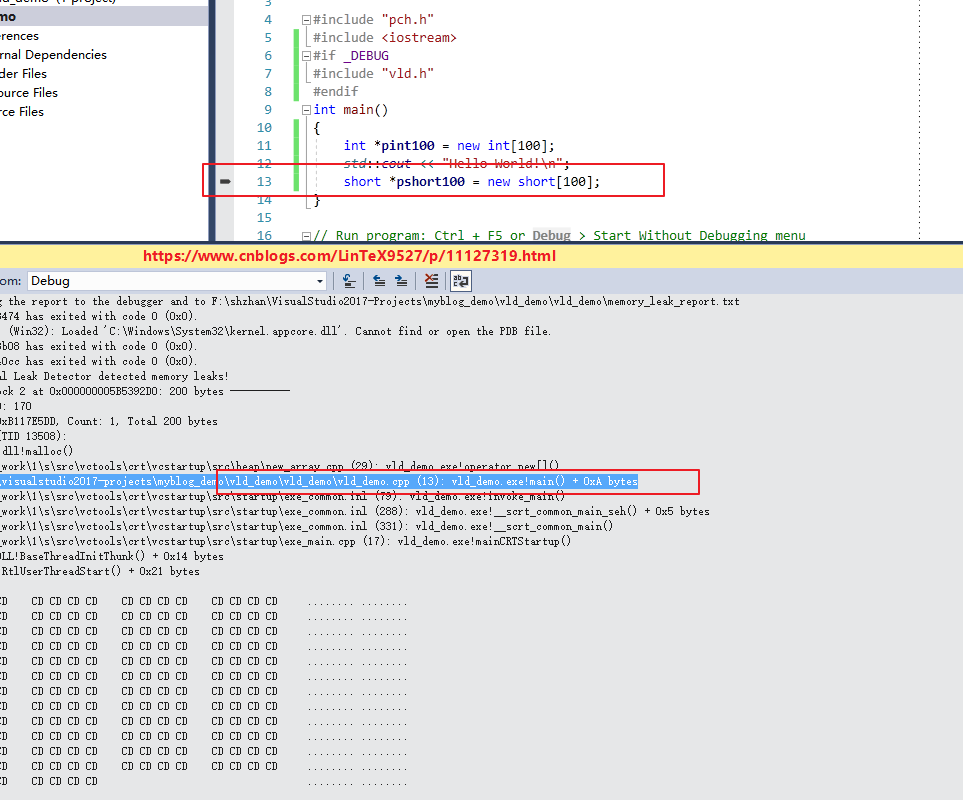
vld.ini 配置檔案
;;;;;;;;;;;;;;;;;;;;;;;;;;;;;;;;;;;;;;;;;;;;;;;;;;;;;;;;;;;;;;;;;;;;;;;;;;;;;;;;
;;
;; Visual Leak Detector - Initialization/Configuration File
;; Copyright (c) 2005-2017 VLD Team
;;
;; This library is free software; you can redistribute it and/or
;; modify it under the terms of the GNU Lesser General Public
;; License as published by the Free Software Foundation; either
;; version 2.1 of the License, or (at your option) any later version.
;;
;; This library is distributed in the hope that it will be useful,
;; but WITHOUT ANY WARRANTY; without even the implied warranty of
;; MERCHANTABILITY or FITNESS FOR A PARTICULAR PURPOSE. See the GNU
;; Lesser General Public License for more details.
;;
;; You should have received a copy of the GNU Lesser General Public
;; License along with this library; if not, write to the Free Software
;; Foundation, Inc., 51 Franklin St, Fifth Floor, Boston, MA 02110-1301 USA
;;
;; See COPYING.txt for the full terms of the GNU Lesser General Public License.
;;
;;;;;;;;;;;;;;;;;;;;;;;;;;;;;;;;;;;;;;;;;;;;;;;;;;;;;;;;;;;;;;;;;;;;;;;;;;;;;;;;
; Any options left blank or not present will revert to their default values.
[Options]
; The main on/off switch. If off, Visual Leak Detector will be completely
; disabled. It will do nothing but print a message to the debugger indicating
; that it has been turned off.
;
; Valid Values: on, off
; Default: on
;
VLD = on
; If yes, duplicate leaks (those that are identical) are not shown individually.
; Only the first such leak is shown, along with a number indicating the total
; number of duplicate leaks.
;
; Valid Values: yes, no
; Default: no
;
AggregateDuplicates = yes
; Lists any additional modules to be included in memory leak detection. This can
; be useful for checking for memory leaks in debug builds of 3rd party modules
; which can not be easily rebuilt with '#include "vld.h"'. This option should be
; used only if absolutely necessary and only if you really know what you are
; doing.
;
; CAUTION: Avoid listing any modules that link with the release CRT libraries.
; Only modules that link with the debug CRT libraries should be listed here.
; Doing otherwise might result in false memory leak reports or even crashes.
;
; Valid Values: Any list containing module names (i.e. names of EXEs or DLLs)
; Default: None.
;
ForceIncludeModules =
; Maximum number of data bytes to display for each leaked block. If zero, then
; the data dump is completely suppressed and only call stacks are shown.
; Limiting this to a low number can be useful if any of the leaked blocks are
; very large and cause unnecessary clutter in the memory leak report.
;
; Value Values: 0 - 4294967295
; Default: 256
;
MaxDataDump =
; Maximum number of call stack frames to trace back during leak detection.
; Limiting this to a low number can reduce the CPU utilization overhead imposed
; by memory leak detection, especially when using the slower "safe" stack
; walking method (see StackWalkMethod below).
;
; Valid Values: 1 - 4294967295
; Default: 64
;
MaxTraceFrames =
; Sets the type of encoding to use for the generated memory leak report. This
; option is really only useful in conjuction with sending the report to a file.
; Sending a Unicode encoded report to the debugger is not useful because the
; debugger cannot display Unicode characters. Using Unicode encoding might be
; useful if the data contained in leaked blocks is likely to consist of Unicode
; text.
;
; Valid Values: ascii, unicode
; Default: ascii
;
ReportEncoding = ascii
; Sets the report file destination, if reporting to file is enabled. A relative
; path may be specified and is considered relative to the process' working
; directory.
;
; Valid Values: Any valid path and filename.
; Default: .\memory_leak_report.txt
;
ReportFile =
; Sets the report destination to either a file, the debugger, or both. If
; reporting to file is enabled, the report is sent to the file specified by the
; ReportFile option.
;
; Valid Values: debugger, file, both
; Default: debugger
;
ReportTo = both
; Turns on or off a self-test mode which is used to verify that VLD is able to
; detect memory leaks in itself. Intended to be used for debugging VLD itself,
; not for debugging other programs.
;
; Valid Values: on, off
; Default: off
;
SelfTest = off
; Selects the method to be used for walking the stack to obtain stack traces for
; allocated memory blocks. The "fast" method may not always be able to
; successfully trace completely through all call stacks. In such cases, the
; "safe" method may prove to more reliably obtain the full stack trace. The
; disadvantage is that the "safe" method is significantly slower than the "fast"
; method and will probably result in very noticeable performance degradation of
; the program being debugged.
;
; Valid Values: fast, safe
; Default: fast
;
StackWalkMethod = fast
; Determines whether memory leak detection should be initially enabled for all
; threads, or whether it should be initially disabled for all threads. If set
; to "yes", then any threads requiring memory leak detection to be enabled will
; need to call VLDEnable at some point to enable leak detection for those
; threads.
;
; Valid Values: yes, no
; Default: no
;
StartDisabled = no
; Determines whether or not all frames, including frames internal to the heap,
; are traced. There will always be a number of frames internal to Visual Leak
; Detector and C/C++ or Win32 heap APIs that aren't generally useful for
; determining the cause of a leak. Normally these frames are skipped during the
; stack trace, which somewhat reduces the time spent tracing and amount of data
; collected and stored in memory. Including all frames in the stack trace, all
; the way down into VLD's own code can, however, be useful for debugging VLD
; itself.
;
; Valid Values: yes, no
; Default: no
;
TraceInternalFrames = no
; Determines whether or not report memory leaks when missing HeapFree calls.
;
; Valid Values: yes, no
; Default: no
;
SkipHeapFreeLeaks = no
; Determines whether or not report memory leaks generated from crt startup code.
; These are not actual memory leaks as they are freed by crt after the VLD object
; has been destroyed.
;
; Valid Values: yes, no
; Default: yes
;
SkipCrtStartupLeaks = yes
宣告
歡迎轉載,請註明出處和作者,同時保留宣告。
作者:LinTeX9527
出處:https://www.cnblogs.com/LinTeX9527/p/11127319.html
本部落格的文章如無特殊說明,均為原創,轉載請註明出處。如未經作者同意必須保留此段宣告,且在文章頁面明顯位置給出原文連線,否則保留追究法律責任的權利
